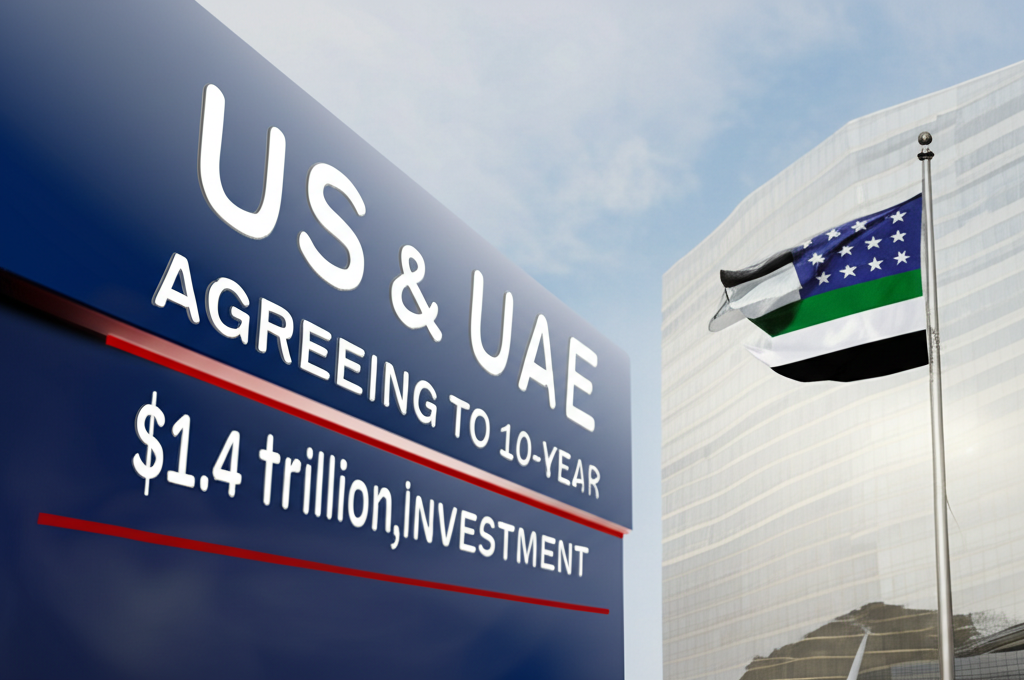
The $1.4 Trillion Handshake: Inside the Historic US-UAE Investment Framework
A New Economic Alliance Reshaping Global Markets
Imagine a bridge, not of concrete and steel, but of capital and collaboration, stretching across continents. That’s precisely what’s taking shape between the United States and the United Arab Emirates in what might be the most consequential economic partnership of the decade. In March 2025, the UAE committed to a staggering 10-year investment framework, pledging $1.4 trillion to fuel the U.S. economy—a figure so large it requires context to fully comprehend.
This isn’t just another foreign investment announcement that makes headlines for a day before fading into the background of global economics. The scale and strategic focus of this partnership signals something much more profound: a deliberate realignment of economic priorities and a bet on the industries that will define our future.
Beyond the Numbers: Understanding the Strategic Vision
The UAE-US investment framework goes far beyond simple capital transfer. It represents a carefully crafted strategy targeting four critical sectors poised to drive innovation and economic growth for decades to come:
AI Infrastructure: Building the Digital Backbone
At the core of this investment is a recognition that artificial intelligence will transform virtually every industry. A substantial portion of the $1.4 trillion is earmarked for next-generation data centers and the power solutions necessary to support them. One flagship initiative within this sector involves a partnership between UAE-based MGX, BlackRock, Microsoft, NVIDIA, and xAI, mobilizing up to $100 billion specifically for data center and energy infrastructure development.
This focus on AI infrastructure acknowledges a fundamental truth of our technological future: processing power and data management capabilities will be as essential to economic growth in the 21st century as oil and manufacturing were in the 20th.
Semiconductors: Securing the Supply Chain
The global semiconductor shortage of recent years highlighted the vulnerability of supply chains and the critical importance of these components to everything from smartphones to automobiles. The UAE-US investment framework aims to strengthen American leadership in semiconductor manufacturing and research, ensuring both technological superiority and supply chain resilience.
By prioritizing this sector, the partnership addresses not just economic concerns but national security imperatives as well. In today’s interconnected world, semiconductor capabilities are inextricably linked to technological independence and competitive advantage.
Energy: Powering Growth While Navigating Transition
Energy investments within the framework span both traditional and renewable sources, acknowledging the dual challenges of meeting growing energy demands while transitioning to more sustainable solutions. A prime example is the partnership between Abu Dhabi’s ADQ and U.S.-based Energy Capital Partners (ECP), which has established a $25 billion investment initiative focused on developing new power generation specifically for data centers.
Meanwhile, ADNOC’s XRG has committed to supporting U.S. natural gas production with significant investment in an LNG export facility in Texas, with plans for further investments across gas, chemicals, energy infrastructure, and low-carbon solutions. This balanced approach recognizes that energy security and sustainable transition must progress in tandem.
American Manufacturing: Revitalizing the Industrial Base
Perhaps the most tangible impact for many Americans will come through investments aimed at revitalizing American manufacturing. This focus on advanced manufacturing technologies and infrastructure aims to create jobs, strengthen supply chains, and enhance national competitiveness in global markets.
The Major Players: Architects of Economic Transformation
Understanding the entities driving this massive investment provides insight into its strategic implications:
| Entity | Role | Key Investments |
|---|---|---|
| UAE Sovereign Wealth Funds | Primary capital providers | Diversified across all four key sectors |
| MGX (UAE-based) | Strategic investor | Leading the $100B AI infrastructure initiative |
| ADQ (Abu Dhabi) | Investment partner | $25B partnership with ECP for power generation |
| XRG (ADNOC-owned) | Energy sector investor | LNG export facility in Texas; further investments planned in gas, chemicals, and low-carbon solutions |
| BlackRock, Microsoft, NVIDIA, xAI | U.S. technology partners | AI infrastructure development and implementation |
| Energy Capital Partners (ECP) | U.S. energy investor | Power generation for data centers |
This collaboration between UAE sovereign wealth funds and major U.S. corporations creates a powerful alignment of interests, expertise, and resources capable of accelerating progress in critical sectors.

Economic Impact: Transformative Potential
The sheer scale of the investment—$1.4 trillion over a decade—guarantees significant economic impact. To put this in perspective, this investment represents approximately 5% of the current U.S. GDP spread over ten years. The framework is expected to:
- Create jobs across multiple sectors, from construction workers building new data centers to engineers designing advanced manufacturing systems.
- Strengthen bilateral trade, which already reached nearly $40 billion in 2024.
- Enhance U.S. technological capabilities in AI, semiconductors, and advanced manufacturing.
- Contribute to U.S. energy security through investments in natural gas production and export facilities.
- Develop critical infrastructure necessary for supporting the digital economy.
For the UAE, the investment aligns with economic diversification goals, moving beyond hydrocarbon dependency toward a knowledge-based economy. By investing in advanced sectors in the U.S., the UAE gains expertise, access to new technologies, and potential new markets for its own products and services.
Strategic Implications: Beyond Economics
The timing and focus of this agreement reveal its importance beyond purely economic considerations. The U.S. has been actively strengthening ties with key partners in the Middle East, and the UAE has emerged as a reliable strategic ally. This investment framework reinforces that partnership and positions both countries for long-term cooperation across multiple domains.
The focus on AI, semiconductors, and advanced manufacturing also signals a shared concern about global technological competition, particularly from China. By pooling resources and expertise, the U.S. and UAE can accelerate innovation and maintain competitive advantages in critical technologies.
Navigating Challenges: The Road Ahead
Despite its tremendous potential, the success of this investment framework is not guaranteed. Several challenges must be addressed:
Regulatory Hurdles
International investments of this magnitude inevitably face regulatory scrutiny. Streamlining approval processes while maintaining necessary oversight will be crucial for timely implementation.
Equitable Distribution of Benefits
Ensuring that the economic benefits of these investments reach beyond major corporations to benefit workers, communities, and smaller businesses will require thoughtful policy and implementation.
Societal Impact
Rapid technological advancement and industrial transformation can disrupt existing jobs and communities. Managing this transition equitably is essential for broad public support.
Geopolitical Considerations
The deepening economic ties between the U.S. and UAE may impact relations with other countries in the region and beyond. Diplomatic skill will be required to manage these dynamics effectively.
Recommendations for Stakeholders
For those looking to capitalize on the opportunities presented by this historic investment framework, several approaches merit consideration:
For Policymakers
Focus on streamlining regulatory processes for investments in key sectors while maintaining necessary oversight. Implement targeted tax incentives and R&D credits to encourage innovation. Most importantly, invest in education and training programs to develop the skilled workforce needed to support growth in these advanced industries.
For Businesses
Seek out collaborative partnerships with companies in both the U.S. and UAE to leverage complementary strengths. Integrate sustainable practices into operations to align with global goals and attract investment. Prioritize cybersecurity as investments in AI and digital technologies increase.
For Investors
Conduct thorough due diligence on specific opportunities arising from the framework. Diversify investments across different sectors and geographies to mitigate risk. Focus on companies and projects with strong long-term growth potential aligned with the framework’s strategic priorities.
Conclusion: A Transformative Partnership
The $1.4 trillion investment framework between the UAE and the U.S. represents far more than just a massive influx of capital. It reflects a strategic alignment of interests, a shared vision of the future, and a commitment to collaboration in addressing critical economic and technological challenges.
As this ambitious partnership unfolds over the coming decade, it will likely reshape industries, create new opportunities, and strengthen the bonds between two nations with increasingly aligned interests. The true measure of its success, however, will be not just in economic statistics but in tangible improvements in technological capabilities, energy security, and industrial competitiveness.
For businesses, investors, workers, and policymakers in both countries, this framework presents both challenges and opportunities. Those who understand its strategic implications and position themselves accordingly will be best placed to thrive in the transformed economic landscape it aims to create.
The $1.4 trillion handshake between the U.S. and UAE may well be remembered as one of the defining economic initiatives of the 2020s—a bold attempt to shape the future through targeted investment and strategic collaboration. As it unfolds, the world will be watching.
What are your thoughts on this historic investment framework? Which sectors do you think will benefit most, and what opportunities do you see emerging from this partnership? Share your perspectives in the comments below.

